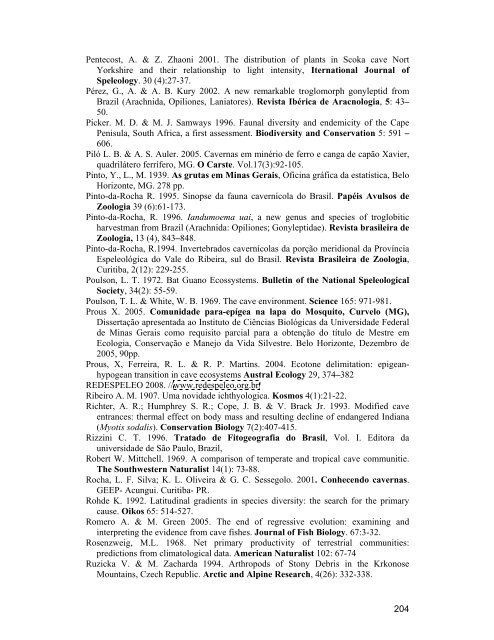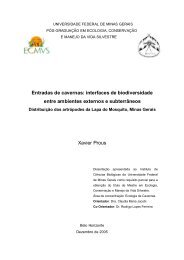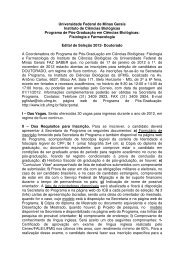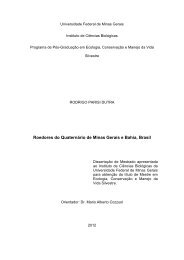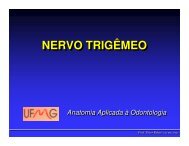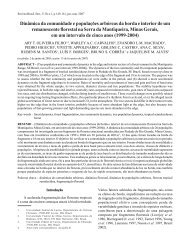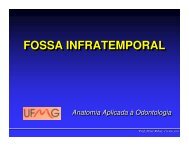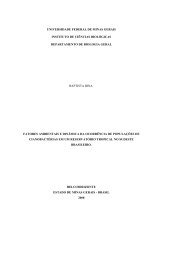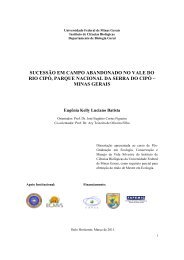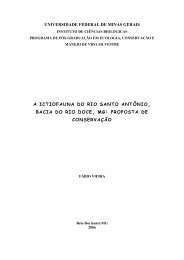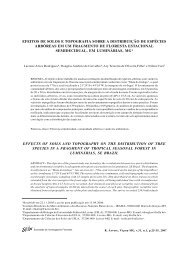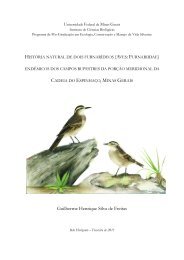ecologi ae conservação das comuni dades de i ... - ICB - UFMG
ecologi ae conservação das comuni dades de i ... - ICB - UFMG
ecologi ae conservação das comuni dades de i ... - ICB - UFMG
You also want an ePaper? Increase the reach of your titles
YUMPU automatically turns print PDFs into web optimized ePapers that Google loves.
Pentecost, A. & Z. Zhaoni 2001. The distribution of plants in Scoka cave NortYorkshire and their relationship to light intensity, Iternational Journal ofSpeleology. 30 (4):27-37.Pérez, G., A. & A. B. Kury 2002. A new remarkable troglomorph gonyleptid fromBrazil (Arachnida, Opiliones, Laniatores). Revista Ibérica <strong>de</strong> Aracnologia, 5: 4350.Picker. M. D. & M. J. Samways 1996. Faunal diversity and en<strong>de</strong>micity of the CapePenisula, South Africa, a first assessment. Biodiversity and Conservation 5: 591606.Piló L. B. & A. S. Auler. 2005. Cavernas em minério <strong>de</strong> ferro e canga <strong>de</strong> capão Xavier,quadrilátero ferrífero, MG. O Carste. Vol.17(3):92-105.Pinto, Y., L., M. 1939. As grutas em Minas Gerais, Oficina gráfica da estatística, BeloHorizonte, MG. 278 pp.Pinto-da-Rocha R. 1995. Sinopse da fauna cavernícola do Brasil. Papéis Avulsos <strong>de</strong>Zoologia 39 (6):61-173.Pinto-da-Rocha, R. 1996. Iandumoema uai, a new genus and species of troglobiticharvestman from Brazil (Arachnida: Opiliones; Gonyleptid<strong>ae</strong>). Revista brasileira <strong>de</strong>Zoologia, 13 (4), 843 848.Pinto-da-Rocha, R.1994. Invertebrados cavernícolas da porção meridional da ProvínciaEspeleológica do Vale do Ribeira, sul do Brasil. Revista Brasileira <strong>de</strong> Zoologia,Curitiba, 2(12): 229-255.Poulson, L. T. 1972. Bat Guano Ecossystems. Bulletin of the National SpeleologicalSociety, 34(2): 55-59.Poulson, T. L. & White, W. B. 1969. The cave environment. Science 165: 971-981.Prous X. 2005. Comunida<strong>de</strong> para-epígea na lapa do Mosquito, Curvelo (MG),Dissertação apresentada ao Instituto <strong>de</strong> Ciências Biológicas da Universida<strong>de</strong> Fe<strong>de</strong>ral<strong>de</strong> Minas Gerais como requisito parcial para a obtenção do título <strong>de</strong> Mestre emEcologia, Conservação e Manejo da Vida Silvestre. Belo Horizonte, Dezembro <strong>de</strong>2005, 90pp.Prous, X, Ferreira, R. L. & R. P. Martins. 2004. Ecotone <strong>de</strong>limitation: epigeanhypogeantransition in cave ecosystems Austral Ecology 29, 374 382REDESPELEO 2008. //www.re<strong>de</strong>speleo.org.br/Ribeiro A. M. 1907. Uma novida<strong>de</strong> ichthyologica. Kosmos 4(1):21-22.Richter, A. R.; Humphrey S. R.; Cope, J. B. & V. Brack Jr. 1993. Modified caveentrances: thermal effect on body mass and resulting <strong>de</strong>cline of endangered Indiana(Myotis sodalis). Conservation Biology 7(2):407-415.Rizzini C. T. 1996. Tratado <strong>de</strong> Fitogeografia do Brasil, Vol. I. Editora dauniversida<strong>de</strong> <strong>de</strong> São Paulo, Brazil,Robert W. Mittchell. 1969. A comparison of temperate and tropical cave communitie.The Southwestern Naturalist 14(1): 73-88.Rocha, L. F. Silva; K. L. Oliveira & G. C. Sessegolo. 2001. Conhecendo cavernas.GEEP- Acungui. Curitiba- PR.Roh<strong>de</strong> K. 1992. Latitudinal gradients in species diversity: the search for the primarycause. Oikos 65: 514-527.Romero A. & M. Green 2005. The end of regressive evolution: examining andinterpreting the evi<strong>de</strong>nce from cave fishes. Journal of Fish Biology. 67:3-32.Rosenzweig, M.L. 1968. Net primary productivity of terrestrial communities:predictions from climatological data. American Naturalist 102: 67-74Ruzicka V. & M. Zacharda 1994. Arthropods of Stony Debris in the KrkonoseMountains, Czech Republic. Arctic and Alpine Research, 4(26): 332-338.204


